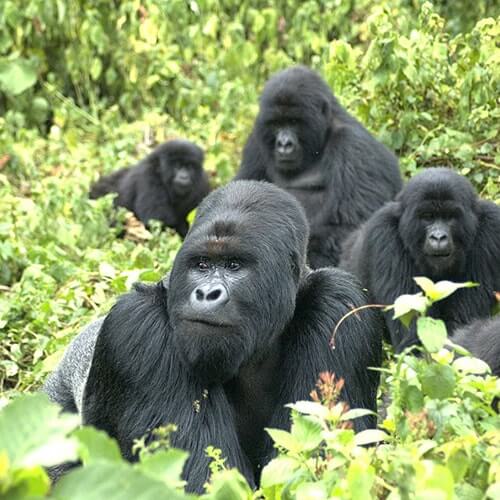Have a Chance to See Mountain Gorillas in Uganda

Would you be able to see him?” whispers our guide Augustine as you go through the thick vegetation encompassing us, yet unpractical eyes can’t locate any indication of life. As we strain our ears to the sound of branches being broken close-by, a shaggy, solid arm rises up out of the foliage, extending a dark rugged hand to pull at a vine. There, only five or six meters away, a mountain gorilla, lying on his back, is caught up with taking off leaves from a branch with his banana measured fingers.
Before long, he knows about our nearness and quickly stumbles off further into the brambles. We were at the Bwindi Impenetrable National, situated in the southwestern piece of Uganda, which is one of the densest rain forests on the planet. Spread crosswise over 320 square kilometers, this antiquated, UNESCO-ensured woods, referred to in the nearby dialect as the ‘dull and chilly’ is home to a large portion of the world’s residual mountain gorilla populace, assessed to be more than 450.
You will depart before dawn, driving higher into the terraced slopes to meet the officers. After our required preparation at the Uganda Wildlife Authority station, our gathering, each equipped with gorilla tracking guidelines along to help explore through the dangerous inclines, set off. In transit, we are cautioned that anybody indicating side effects of an icy ought to uncover it and backpedal. Sicknesses can be passed from people to creatures, so this is a honest to goodness concern. Possess up now and you’ll get a discount; on the off chance that you endure, and afterward indicate side effects, you’ll be escorted out of the recreation center with no discount, the officer exhorts us.
The well knowledgeable conveying guides wearing armed force style exhausts rapidly alerts us that while there is a 99 for each penny possibility of seeing the gorillas here and the trek to discover them can go somewhere in the range of 40 minutes to six hours. Much to your comfort, you are educated that a group of trackers has left at a young hour in the morning to find the directions of the immense chimps to spare us time and exertion.
A walk in the forest to see Mountain Gorillas
It takes three hours of tiring strolling alongside hard arrivals and tumbles to achieve the gorilla’s campground. The deeper you enter into the forest, the denser and wilder the forest became as we finally left the comparatively open trail and began to make our own way with machetes. You will accompanied by your porters who are young boys from nearby towns that come to Bwindi to get money so that they are able to supplement on their school fees. These will be helping you to carry small pack bags that you may have carried.
At the point when the going got vertical, you can hold out your porters hands or walking sticks so that you are able to move through as slippery endless tangles of roots and the thick vines lashing with in reverse branches. The wet leaves sprinkled on the ground is slippery, the hurtful nettles and uneven, untried trails urged utmost caution while the impossible tangle of green made it difficult to push forward. “Keep going,” our guides encouraged our exhausted group as I felt the sweat trickle down my back.
No matter how much I wanted out, I had no choice but to push on, because it’s impossible to go back without rangers slicing pathways through the wild bush. You will continue with a move on a muddy waterlogged shoes, twisted ankle and weakening enthusiasm. The guides know where the gorillas were yesterday, so now it’s a question of finding where they spent the night. After a few meters, he holds out a half-eaten branch, leftover over by the gorillas that had camped nearby a night before. Guides will inform you that with the sight of droppings, broken vegetation and leftover food, he can estimate the direction they’re travelling. Once the nests are located, the gorillas, which generally don’t move more than a kilometer a day, won’t be far away.
Legacy of misfortune
As you wait for trackers to locate the gorillas, you can ask your guide about the human population in Bwindi. They will provide you with information about the Batwa pygmies, the original dwellers of this ancient jungle. Till recently, Bwindi’s mountain gorillas shared their forest with the Batwa pygmies, a tribe of hunter gatherers who lived in its caves and trees for more than 4,000 years. Although they never hunted gorillas, the Batwa’s closeness increased the risk of infection to animals that share 98 per cent of human DNA.
Around 1992, the lives of the Batwa pygmies changed forever when the Bwindi Impenetrable Forest became a national park and World Heritage Site to protect the endangered gorillas within its boundaries. Conservation initiatives such as habituating gorilla families for tourism have seen an increase in number of these favorably endangered animals. All the mountain gorillas that are tracked by visitors go through a process known as ‘habituation’, through which rangers gradually accustom them to humans.
Park staff spends hours each day trailing after the animals until the great apes learn to ignore or at least tolerate human presence. Augustine explains that they’d all learned to mimic the gorillas’ noises, especially the low, whispering rumble used to keep the silverback calm. During the process, they even imitate the gorilla’s gestures and behavior such as crouching down and munching on the leaves to demonstrate their friendly intentions.
Up, close and personal with Mountain Gorillas
A radio coughs is assign to alert you that the trackers have located a group. Excitement levels increases and you will follow the guide. After the first gorilla experience with the young black back, continue following your guide to find other members of the family busy cracking, crunching and munching. You might find about five of them including a mother with a two-year baby. Keep watching as they lie on their backs, holding his feet in one hand and scratching his chest with the other, unconcerned though not unaware of our presence.
You will see them rolling over on his haunches and begins pulling down thick brown vines and swings on it as if to show off his skills. As you busy capturing his antics with your cameras, another gorilla might see you with that a bored look and there you have to stop in case you have been taking pictures. While they can climb, these heavy primates are far more comfortable on the ground. It feels like hours have passed when the guide declares we must leave and head back. And as if one a cue, the family disappears inside the bushes indicating that your time is up. The trek back takes longer as the trackers hack into the undergrowth, bidding follow.
This is a different route and more difficult route as the gorillas were building nests in the former route. The descending is steep and so deceitfully slippery that you will frequently resort to the safety of sliding on your bottom which somehow very interesting .Indeed this walk will always stick in your mind and it will be one of the best memories during the trek.
FACT FILE
Getting there Uganda Ethiopian Airlines has the best connection to Entebbe in Uganda
• Transportation from Kampala to Bwindi Park can be difficult, so allow for two full days on the road before the date of your trekking permit. The cost of a gorilla permit in Bwindi is $ 700
• Bring in light raincoat/waterproofs, lightweight-hiking trousers and long-sleeved top, hiking boots with ankle support, gardening gloves for handling nettles on the trail.
• A Yellow Fever Certificate is required
